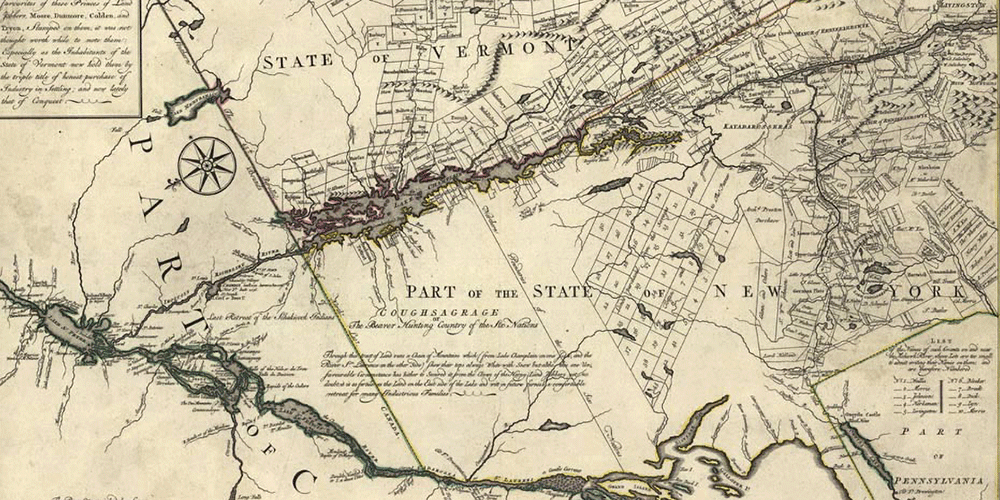You cannot believe everything you read on the internet. If you’ve read that the word “verts monts” (green mountains) was first used by Samuel de Champlain in 1609, we believe it’s wrong.
An excellent, well-referenced – but yet incomplete – article by Joseph-André Sénécal*, a University of Vermont professor, now retired, looked into the question. According to him, it seems that Champlain did not mention “verts monts” in his travel journals.
In that article, he also explains that the expression was not used either in texts from Louis-Antoine Bougainville or the Jesuits’ writings nor can it be seen in French maps of the Champlain Valley.
He goes on to say that the first written text where the word Vermont appears is a text by Thomas Young, dated April 11, 1777. “On that day, in Philadelphia, Thomas Young addressed a broadside “To the Inhabitants of Vermont, a Free and Independent State”.”
From that finding, Sénécal goes on to look into the use of the English expression “Green Mountains” in texts and maps, as his hypothesis is that the term Vermont was actually “created” from the English expression “Green Mountains”.
His research on the origin of the expression “Green Mountains” is interesting. The first written text mentioning “Green Mountains” is a text attributed to Ethan Allen and dated August 1772, “An Encomium on his Excellency Governor Tryon and his Majesty’s Honourable Council of the Province of New York”, published in the Connecticut Courant.
It was in the spring of 1772 that the most violent elements of resistance to the New Hampshire grantees had begun calling themselves the Green Mountain Boys. It would make sense, adds the author, that the term Green Mountains became common a few years prior, sometimes in the late 1760s. There were no more than 300 English settlers in Vermont in 1760, he adds.
Additionally, the first map with the mention Green Mountains dates from 1778. “The first edition of Bernard Romans’ A Chorographical Map of the Northern Department of North-America […] clearly delineates a mountain range with hachures and labels its southern end (diagonally, from Wallingford to Bennington) as the “Green Mountains”” Sénécal mentions.
Interesting stuff. But who was Thomas Young? What was his connection to Vermont? What happened to explain that from that mention in April 1777, the young republic was named Vermont less than 3 months later, in Windsor, when the constitution was written?
There has to be more to the story. And if it is assumed that the term Green Mountains was used commonly before it appeared in texts and maps, shouldn’t we make the same assumption about the term Vermont?
Could it be that the term Vermont was used by the few hundred French settlers in the Champlain Valley in the 1730-1750s?
And/or could it be that the Abenakis or other local Indian communities called these mountains “Green Mountains” (in their language) for years and that either the French or the English took the name from them?
As far as we are concerned, these are very interesting questions that were not answered by Sénécal’s article. Some more research was definitely needed!
Well, as surprising as this hypothesis is, that the French word Vermont actually came from the mind of an English-speaking gentleman, we have not found any proof that it could come from the French nor the Abenakis.
However, two Wikipedia pages (Old Constitution House and on Thomas Young) explain better how Thomas Young was connected to the naming of Vermont by the Vermont Constitutional Convention in 1777.
We learn that Young was a mentor for Ethan Allen and that he suggested the name of Vermont for the new state north of Massachusetts, which was originally called New Connecticut, in a letter which was read at a meeting of representatives of New Connecticut in Windsor on June 4, 1777.
Thomas Young was indeed in favor of independence and he urged the adoption of the name “Vermont” and the creation of a constitution for Vermont. His reasoning for the name was that most of Vermont was in the Green Mountains, so he suggested combining “vert” (green) with “mont” (mountain) to honor the Green Mountain Boys.
I am still curious though to understand who gave the name “Green Mountains” to that mountain range and if it was an expression used by Native Americans!
* Dr. Sénécal also spent 30 years studying the presence of French settlers in the Champlain Valley in the 18th century.

